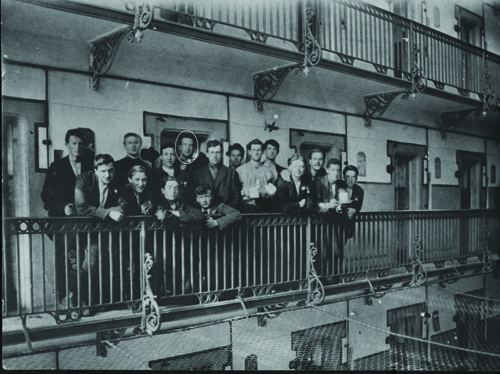A flavour of the collection
Published in Features, Issue 3 (May/June 2014), Volume 22
1916 Rising
Records and documents relating to Easter Week 1916 are contained in a series of files catalogued under ‘Membership and Organization’, including IRA Nominal Rolls and reports by Cumann na mBan, Na Fianna Éireann and the Irish Citizen Army. The most important of these files include the ‘Nominal Rolls for Easter Week 1916’ compiled by all five Dublin battalions of the Irish Volunteers, the Citizen Army and Cumann na mBan; details of the Rising outside Dublin are covered in ‘Brigade Activity Reports’ for Galway, Louth/Meath and Wexford. While the brigade and battalion reports for Dublin consist largely of lists of participants, the level of detail provided by the senior veterans is disappointing, with varying degrees of effort employed in providing the full names and addresses of participants and precise details of organisational structures. The brigade reports from the country districts that participated in the Rising are more detailed and include the texts of cross-examinations of the oral testimony of senior veterans and precise details of the activities of the Volunteers in Galway, Louth/Meath and Wexford.
‘Saved the name of Tipperary’
Volunteer Michael O’Callaghan of Tipperary was responsible for one of the most obscure incidents of the 1916 Rising. O’Callaghan was on the run from police when he shot dead two RIC men, Thomas Rourke and John Hurley, who entered a house in which he had been hiding out during Easter Week on the Limerick border. O’Callaghan’s pension file (MSP/34/REF/4189) reveals that after months on the run he escaped to New York, where he became involved in an ill-fated attempt to ship guns to the Volunteers and was jailed pending extradition. He returned to Ireland in 1923 and became a district court clerk and subsequently a creamery manager. In support of O’Callaghan’s claim for a pension, senior veteran and IRA legend Dan Breen told the Military Service Pensions Board that O’Callaghan had ‘saved the name of Tipperary by his actions during that famous week’, adding that ‘I only wish we had some more like O’Callaghan, [and] 1916 would not have faded out as it did’.
‘Threatened’ to return home
Volunteer Francis Teeling was shot and captured by the Crown forces for his role in Bloody Sunday, 21 November 1920, when Michael Collins organised the execution of thirteen British agents across Dublin. Teeling managed to escape from Kilmainham Gaol in March 1921, subsequently took the Free State side in the Civil War and was wounded in action for a second time while serving in Munster. Teeling’s pension file (MSPC/24/SP/913), however, reveals a darker aspect to his life; in April 1923 he was dismissed with ignominy from the National Army after killing William Johnston (a member of the Citizens’ Defence Force) in the bar of the Theatre Royal on 27 March. Released from jail after a sentence of less than two years, Teeling adopted a pseudonym and emigrated to Montreal. His successful application reveals that he ‘threatened’ to return home if not awarded a pension, prompting General Richard Mulcahy to endorse the award, as ‘[Teeling] had publicly misconducted himself in such a way on a number of occasions as to run the danger of bringing serious discredit to us’.
IRA membership rolls
The IRA membership rolls provide details of the membership and organisational structure of the sixteen divisions of the IRA, constituting a total of 87 brigades, on two crucial dates—11 July 1921 and 1 July 1922. Comprising a total of 49,982 individual documents, these files were collated around 1935 and the key dates employed by the board will allow researchers to analyse the changing nature of the organisation in the crucial period between the Truce and the commencement of the Civil War.
Belfast pogroms
The level of detail in the reports varies; some include the activities of Crown forces and document the fearsome levels of violence in certain parts of the country. The report of the 3rd Northern Division (Files RO 402–406A), encompassing Belfast, Antrim and Down, underlines the frightening level of sectarian violence facing the Catholic community in Belfast and contains the following entries: 21 July 1920, Belfast Catholics chased from shipyards; 22 July 1920, military fire on crowd on Cupar Street, three killed; 23 July 1920, Clonard [monastery] lay brother shot dead and 200 wounded; 18–21 April 1922, onslaught on Marrowbone [district of Ardoyne], Annie McAuly, James Parron, Glenpark Street, Denis Diamond, 19 Vulcan Street, killed, John Walker, Short Strand, killed, and Andrew McCourteny, Dagmar Street, killed (MA/MSPC/RO/401).
Conclusion
The release of these files will not force a radical reconsideration of the overall narrative of the Irish revolution; it will, however, make future research more reliable, infinitely more detailed and decidedly more interesting. The nature of the precise details contained in these reports complements the more expansive personal narratives contained in the Bureau of Military History Witness Statements and made available to the public in 2003. Upon exploring this collection, presented in an accessible and user-friendly fashion, any frustration one might have felt at the length of time it has taken for this information to be released evaporates. This is a monumental achievement by Military Archives and those involved deserve the very highest of plaudits. The history of the Irish Revolution has truly been democratised and the capacity of academics and non-academics alike to explore the Independence struggle has been transformed.
Conor McNamara is the co-author of Easter 1916: a research guide, to be published by Four Courts Press later this year.
Read More: Who Qualified?
Further reading
C. Crowe (ed.), Guide to the Military Service (1916–1923) Pensions Collection (2012).
















